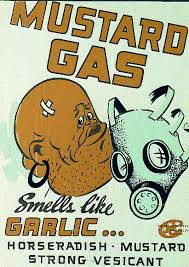All of us know someone who has had cancer. We talk about radiation and chemotherapy but have you ever wondered where and how it all started?
I came across a post through a Facebook page called “Reactions” that intrigued me. It was called “How Chemistry Changed WWI”. After reading through it I would have titled it, “How Chemical Warfare Killed and Saved Millions”. It was a tiny article that talked about how WWI was called the chemists war.
Most people know that mustard gas killed so many soldiers, innocents and living things during WWI but too few also know that mustard gas changed how medicine treated cancer.
In the later 20th century cancer was treated surgically (removal of tumors) and with x-rays. Scientists realized that when x-rays were used on the skin at high intensities it caused a burn, they researched the application of x-rays to combat disease and discovered that tumors were cured or reduced. When Marie and Pierre Curie discovered radium, a bridge was made and experimentation with radiation had begun. The history of radiation is a story of its own and something I may cover later. It is truly fascinating.
At the end of WWI, it was discovered that the mustard gas had a property that decreased white blood cells. When testing for cancer a doctor will examine the total number of white blood cells in your system; an increase indicates a problem. Research into different types of mustard gas continued, especially during the 1930’s when governments feared the use of it by Germany. During this time mustine (a chemotherapy predecessor) was discovered. An accidental release of mustard gas in Italy showed the same results as in WWI. This led to the study of mustine medicinally. In 1942, Yale University began researching its effect on Hodgkins lymphoma and other types of lymphoma and leukemia. Mustine became the first chemotherapy drug.
“What is interesting about science is the boring truth is that it usually advances incrementally, through the steady accretion of data and insights gathered by many people over many years (Joel Achenbach)”.

